As we have seen, there are plenty advantages to EVs even before considering the environment. The environment is a massive and complicated and political topic. We will discuss air pollution, greenhouse gas emissions, electricity generation, and battery materials, disposal and recycling.
Air Pollution
Burning fossil fuels such as coal, oil, natural gas, gasoline and diesel produces air pollutants, which are materials that negatively impact humans and the environment. Common pollutants that can come from ICEVs:
- particle pollutants (PM₂.₅ or PM₁₀, depending on size in micrometers)
- lead (Pb)
- nitrogen dioxide (NO₂)
- carbon monoxide (CO)
- sulfur dioxide (SO₂)
These pollutants contribute to respiratory illness and death, visible smog, acid rain and depletion of the ozone layer. We have had some successes reducing air pollution. The most famous example is the Montreal Protocol, a plan to phase out various chemicals that created the hole in the ozone layer. This hole is now closing. Other strong environmental controls including the addition of catalytic converters resulted in a reduction of acid rain and smog. And phasing out of leaded gasolines drastically reduced lead pollutants.
Greenhouse Gas (GHG) Emissions
Greenhouse Gas (GHG) emissions are a subset of air pollutants that contribute to the greenhouse effect which traps heat in our atmosphere and contributes to global warming. They are sometimes referred to as global warming emissions or simply emissions. Calling a car clean or dirty refers to its GHGs emissions.
The main GHGs are:
- carbon dioxide (CO₂)
- methane (CH₄)
- nitrous oxide (N₂O)
- fluorinated gases (CFCs, HCFCs and HFCs)
CO₂ is the biggest component of GHGs, and all GHGs are measured in tonnes of carbon dioxide equivalent (t CO₂-eq).
Carbon Capture
Carbon capture is a way to capture carbon dioxide (CO₂) to limit or reduce it in our atmosphere. It has potential to make both ICEVs and EVs cleaner. It comes in two main styles:
- Post-Combustion Carbon Capture is what most people mean by carbon capture, and it makes up the majority of all carbon capture in use today. It can be used to capture CO₂ waste from any industrial processes such as cement production, therefore making the industrial process net neutral for CO₂. Importantly for EVs, it can be used to generate electricity from fossil fuels with no CO₂ emissions. Importantly for ICEVs, it can eliminate CO₂ emissions generated during production of gasoline or diesel fuels.
- Direct air carbon capture removes CO₂ out of the atmosphere and is therefore net negative for CO₂. If we use this captured CO₂ to make hydrocarbon fuels to burn instead of gasoline or diesel, then we can offset CO₂ emissions from the tailpipe. That is, if we burn fossil fuels we got out of the ground, we are adding CO₂ to the atmosphere, but if we burn fuels we made using CO₂ we took from the air, we are just putting it back and won’t increase CO₂ levels.
It should be noted that carbon capture is not intended to remove any of the other pollutants or GHG emissions aside from CO₂.
Life-Cycle Emissions
EVs produce lower greenhouse gas (GHG) emissions than ICEVs. For many years, people claimed that this was not the case, but the numbers are clear.
The chart below from the International Energy Agency [IEA] compares the types of vehicles with their life-cycle GHG emissions. The emissions are broken up by:
- Vehicle Components and Fluids: Similar across all vehicles except FCEVs, which generate more emissions.
- Vehicle Assembly, Disposal and Recycling: The same across all vehicle types.
- Vehicle Batteries: Battery manufacture emissions estimates included a relatively clean process such as Europe (shown in solid green) and added the extra emissions from a relatively dirty process such as China (shown in hashed green). If the world improves to current European standards the hashed green area would disappear.
- Well-to-tank: For ICEVs, the emissions from gasoline or diesel production. If carbon capture is used, these emissions can be eliminated. For EVs, the emissions are from electricity production. If the grid uses entirely clean sources, these emissions can be eliminated. For FCEVs, this represents the emissions from hydrogen production. If electrolysis is used, these emissions can be eliminated.
- Tank-to-wheel: No emissions are generated by EVs during the conversion of electricity to motion. For ICEVs and partially electric vehicles this represents the tailpipe emissions due to combustion in the engine.

As a reminder, BEVs are Battery Electric Vehicles (in either 40 kWh or 80 kWh configurations in the chart), ICE are Internal Combustion Engine vehicles, HEVs are Hybrid Electric Vehicles (that can't be plugged in), PHEVs are Plugin Hybrid Electric Vehicles and FCEVs are Fuel Cell Electric Vehicles.
The strongest takeaways from this chart:
- EVs are not totally clean, but they have potential to be far cleaner than ICEVs. Even if we eliminate well-to-tank emissions, EVs still generate GHG emissions from initial vehicle manufacture, battery manufacture and final disposal. EVs would still emit ~10-14 t CO₂-eq, or roughly 30–40% of the ~34 t CO₂-eq emitted by today’s ICEVs.
- HEVs and PHEVs perform comparably with BEVs. This implies that from an environmental perspective we should continue to develop HEVs and PHEVs in parallel with development of new BEVs (which cost more to develop). If PHEVs with adequate range for most trips are developed, they may rarely use fuel, if ever. It should be noted that as the grid gets cleaner BEVs will get better much faster than HEVs.
- FCEVs have the highest emissions from their initial production.
- ICEVs cannot eliminate most (~70%) of their emissions. They will always generate emissions in their engines and output it from their tailpipes. However, they can reduce well-to-tank emissions through post-combustion carbon capture. They can also offset tank-to-wheel emissions by burning fuel from direct-air carbon capture.
Dirty Electricity Sources
EVs are only as clean as the electricity you use to power them. If you burn coal to generate electricity to charge your vehicle you simply do not have a zero emissions vehicle. It could even be thought of as a coal-burning vehicle. But how dirty would it actually be?
To compare emissions between EVs and gasoline vehicles, the Union of Concerned Scientists first calculated the emissions generated by charging and driving the average EV in regions that use different mixes of generation sources (coal, hydro, nuclear, wind, solar) as identified by the EPA. Then, they converted this number to MPG for an ICEV with the same emissions. That is, to be as clean as the average EV, an ICEV would have to be at least as efficient as shown on the map below:

As we saw in the efficiency section, the best gasoline ICEV on the market in the past 5 years is the 2017–2021 Mitsubishi Mirage at 39 MPG, which is therefore cleaner only than an average EV in HIOA (O’ahu, Hawaii) and ties for cleanliness in the MROE (Midwest Reliability East). For a gasoline ICEV to be cleaner than an EV, it would need to get ridiculously high mileage of 122 MPG in California or 231 MPG in New York. When the same calculations were done for the most efficient vehicle, the 2020 Tesla Model 3 Standard Range Plus, the numbers were more stark. The EVs smash the gasoline cars in every region and are way cleaner. Gasoline cars would need to achieve 49 MPG to compete even in the worst region of O’ahu, Hawaii.
From the report, 94 percent of people in the US live where driving an average EV produces less emissions than a 50 MPG gasoline car. It is clear that EVs are cleaner than electric, even when including emissions from the generation source. As the grid gets cleaner and EVs get more efficient, the gap will only widen. Even old EVs already on the road will get cleaner.
For a similar analysis in Canada, see the Canadian Energy Regulator market snapshot. It is interesting to compare Alberta (mostly coal-fired power at 900 grams GHG/kWh) to British Columbia (mostly hydro power at 11.7 grams GHG/kWh) to see how EVs are way cleaner than ICEVs with a clean electricity source. On the contrary, in Alberta the Honda Civic ICEV outperforms 5 BEVs and 3 PHEVs, and produces 25% less emissions than a Tesla Model X. This shows that ICEVs can be cleaner than EVs when powered by a dirty electricity source.


Clean & Stable Grid
To make EVs truly zero-emissions we need to move towards a fully clean and stable electrical grid:
- generating electricity with clean or renewable energy sources such as nuclear, wind, solar or fossil fuels with carbon capture
- integrating storage in the grid using batteries to prevent blackouts and brownouts when the intermittent energy from wind and solar is not available
- connecting far away regions with a network of high-voltage DC lines to stabilize the grid so that regions can send power to each other when needed
- implementing a carbon tax to incentivize development of clean or renewable energy and to reduce emissions. We will go into carbon taxes in a separate post.
Grid improvements are a huge and complicated topic of their own and we won’t dive any deeper at this time.
Battery Materials
The battery pack in an EV is large and needs a variety of raw materials. The most common battery currently used in EVs are Lithium-ion. Depending on their design, they use various mixes of lithium, nickel, manganese, cobalt, aluminum, iron, graphite, copper and more. Batteries currently consume more than half the global production of lithium and cobalt.
Cobalt, Human Rights & the Environment
The most problematic source material for lithium-ion batteries. Cobalt is expensive to mine, and half of the global cobalt reserves and 70% of today’s production are in the Democratic Republic of Congo (DRC). The artisanal mining practices face serious human rights and environmental issues originally highlighted by Amnesty International [2016]. Because of the cost, human rights and environmental issues, battery manufacturers are trying to reduce the amount of cobalt per kWh. But at the same time, battery pack sizes are increasing and more cars are being produced. The result is that cobalt requirements for EVs will increase in the coming years.
Battery Recycling and Disposal
It is expected that the global demand for all batteries (not just for EVs) will increase by 5- to 17-fold over the next 20 years. Recycling can significantly offset the need to mine these materials. The Union of Concerned Scientists [2021] estimated recycled materials could meet 30–40% of the US demand for EV batteries by 2035. Today, recycling only makes up <10% of the demand for EV batteries and should be scaled up.
When battery packs are no longer of use in an EV (which requires high-performance) they may still have a “second life” sitting stationary for at-home storage or for commercial grid stabilization.
The issues surrounding batteries including source material availability, cobalt mining issues and quickly increasing demand may seem overwhelming. But we can do better.
Next, on to Cool Capabilities!
Header image credit: Grant Ritchie
